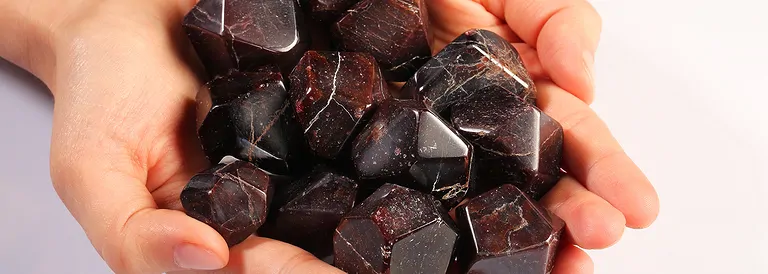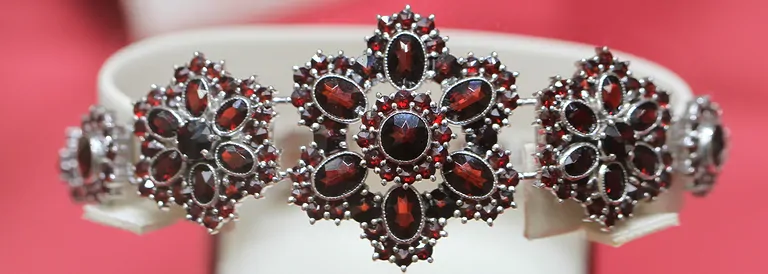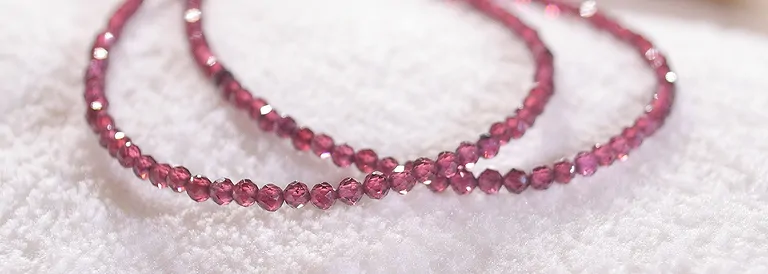
Garnet - meaning, effect and application
Granat is a good support at the start of a new project, a new task or a new stage in life. Granat helps you not to lose sight of the supposedly small, unimportant tasks of everyday life despite all the joy and all the beautiful, positive things in life. With the support of the mineral, you can work hard to accomplish them and pursue your goals with perseverance.
At the same time, the dark red stone also promotes the ability to let go of useless or outdated ideas and approaches and to develop new ideas. The power of this gemstone can make it easier to try out new approaches and overcome initial resistance.
Garnet gemstone strands, massage stones, jewelry, tumbled stones and slab stones at wholesale prices
Origin of the name garnet, synonyms and varieties
The name "garnet" comes from the Latin word "granatus" (small, grain-like) or "granum" (grain, kernel). The name refers to the spherical shape of the garnet, which is reminiscent of the seeds of the pomegranate. The red color of garnet is also reminiscent of pomegranate. Until the 19th century, various minerals were referred to as garnet based on their physical characteristics. With increasing scientific research methods, the term garnet was defined more and more precisely.
The term garnet is now used to describe an entire group of minerals rather than a single mineral. The garnet supergroup with 32 species has existed since 2012. This was described and defined by the Naming Committee of the International Mineralogical Association (IMA-CNMNC).
Best-known representatives of the garnet group
Almandine - dark red garnet; named after the ancient gemstone city of Alabanda). Misleading names are Ceylon ruby and Alabana ruby.
Andradite - greenish-yellow to brown garnet; named after the Portuguese garnet researcher J.B. d’Andra da Silva. Synonyms are calcareous iron garnet, garnet jade and pitch garnet. Chromium-bearing andradite is called dermantoid, titanium-bearing andradite is called melanite.
Grossular - olive green to green garnet; the name is derived from the botanical name Grossularia for the gooseberry.Popular names are gooseberry stone, cinnamon stone or canel stone, misleading Californian ruby and South African jade.
Hessonite - honey-colored to orange-red variety of grossular with a lower iron content

Pyrope - red garnet (böhmic garnet); the name is derived from the Greek word for flint. Historical names are böhmic garnet and böhmic ruby.
Rhodolite - pink garnet, named after the Greek word Rhodes for rose due to its color. Also known as oriental garnet and
Spessartine - yellow to red-orange garnet; named after the historical site where Stengerts was found in the Spessart region. Particularly bright spessartine is also called mandarin garnet, other names are brownstone silica and manganese garnet.
Tsavorite - bright green variety of grossular; named after the place where it was found on the Tsavo River in Kenya
Uvarovite - emerald green to dark green garnet; named after S.S. Uvarov. Synonyms are chrome garnet and trautwinite.
In addition, there are a large number of mostly little-known varieties, e.g. elbrusite, holstamite, catoite, montenevite, usturite and yafsoanite as well as minerals whose classification as garnet is still being scientifically investigated, e.g. eltyubyuite and wadalite.

Mineralogical profile of Garnet
Chemical formula: depending on the garnet variety
Mineral class: Island silicates, garnet family
Origin: metamorphic, in crystalline schists and gneisses, but magmatic origin also possible
Color: all colors possible; depending on the garnet variety
Sheen: Vitreous luster, oily luster, resin luster
Crystal system: cubic
Mohs hardness: 6 to 7.5
Cleavaability: imperfect cleavage, conchoidal fracture, splintery, brittle
Localities, main supplier countriesr: worldwide; in trade mostly from Australia, Brazil, China, India, South Africa and the USA. The largest garnet ever found is around 2.3 meters in size and weighs approx. 37.5 tons; found in Kristiansand (Südnorway).
The Granatium - a garnet museum with tunnels and shafts - provides an exciting insight into the mining of garnet.
Appearance: ingrown in rock, often beautiful, idiomorphic crystals, rhombic dodecahedron
Use: Garnets are classic gemstones that come in many varieties. Almandine and pyrope are mainly used in gemstone healing. In astrology, garnet represents the inner fervor, endurance and transformative power of those born in Scorpio. In the Native American Medicine Wheel, it is the totem of the Stör Moon (constellation Löwe).
Availability: good to rare (depending on variety)
Garnet stinged beads, massage stones, jewelry, tumbled stones and smooth stones at wholesale prices
Garnet in gemstone healing
In gemstone healing, garnet is often used in difficult, seemingly hopeless situations. With the support of the mineral, it is easier to master all kinds of tasks and challenges.
With the help of the garnet, you can also focus on the well-being of others – crises can only be overcome if you look beyond your own nose and support each other.
Granat conveys joie de vivre and strength of will, confidence in one's own abilities and knowledge is supported. In this way, resistance and obstacles can become challenges that need to be overcome. With perseverance, new ideas and a forward-looking approach, goals can be achieved despite the difficulties that arise.
Special varieties of garnet are used in some situations:
Almandine: Imagination, strength, drive, willpower
Andradit: Flexibility, creativity, orientation
Grossular: Regeneration, helpfulness, hope
Hessonite: Growth, balance
Melanit: Sincerity, stability, trust
Pyrope: Serenity, courage, endurance
Rhodolite: Confidence, cordiality, optimism
Spessartin: Cleverness, courage
Uvarovite: independence, companionship, creativity
Garnet as a water stone
The basic theme of garnet as a water stone is the commitment to improve the circumstances of life - this applies both to one's own life and to the lives of others such as family members, friends and colleagues. Crises can be overcome more easily, joie de vivre, self-confidence. Hope and courage are supported.
All common methods of producing gemstone water (direct immersion, test tube, infusion) are suitable; caution is advised with the steam and boiling methods. This can cause the garnets or the surrounding mother rock to shatter. Energizing water using discs on which a glass or jug is placed is not possible due to a lack of suitable stones.

Garnet as a wellness stone
The red garnet almandine is used for gemstone massages, as the mineral can have a supportive effect in various areas. It is easier to let go of what is useless and outdated, and the openness for new ideas and the courage to implement them is strengthened. A beautiful massage stone for partner massages! Only almandine is used as a massage stone, as the other members of the garnet group only form smaller crystals from which no reflex zone styli, spheres or other shapes can be cut.
Garnet is also popular as a stone for meditation. Raw stones or crystal groups on mother rock can also be used for this purpose.
In Gemstone Balance, garnet together with ruby and rose quartz form the "Joy of Life" blend.
Use of Garnet as a gemstone for jewelry
Pyrope from Böhmen can be collected from the banks of the local rivers with little knowledge and equipment and is therefore found in this area as a Bronze Age burial gift and gemstone. Traditions from ancient Greece and Egypt show that garnet was used there both as a gemstone and as an amulet. In the Bible, garnet is mentioned in the Book of Exodus 28, 18 as one of the gemstones on the breastplate of Hoshen, the high priest Aaron (approx. 520 BC).

Garnets experienced a second golden age from the 17th century to the early 20th century due to the rapid advances in cutting techniques. Famous cutting workshops were established near Freiburg im Breisgau and in Turnov (Turnau) near Prague. The heyday of garnet jewelry lasted from around 1850 to 1900, and it is estimated that around 10,000 people were employed in the various areas of garnet jewelry production during these decades. During the Art Nouveau period, garnets from the Bohemian rivers, which were running out, faced competition from South Africa and fashion favored other gemstones.
Today, the various garnets enjoy great popularity as gemstones due to their unusual colors. Whether as a faceted cabochon in sparkling stud earrings, as a sporty bracelet with elastic thread or in unusual pieces of jewelry made from garnet necklace strands - garnet jewelry is more popular today than ever!
Outstanding pieces of jewelry with garnet are still on display today, for example in the Czech National Collection, in the Kunsthistorisches Museum in Vienna, in the Hermitage Museum in Moscow and in the Grünen Gewölbe in Dresden.
Silver jewelry with garnet at wholesale prices
Importance of garnet in technology and industry
Garnet is used in industry as an abrasive and polishing agent in the processing of surfaces, e.g. for sandblasting. An admixture of garnet has also proven itself as an abrasive when cutting material and is used in water jet cutting. Garnet is also used when cleaning drilling pipes and breaking up rock for fracking.
Artificially produced yttrium-aluminum garnets are used in laser technology and were initially an important component in the production of LEDs.
